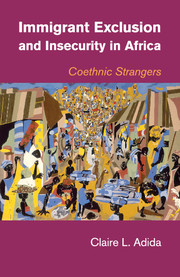Book contents
- Frontmatter
- Dedication
- Contents
- List of Figures
- List of Tables
- Acknowledgments
- 1 Introduction
- 2 Immigrants and Their Leaders
- 3 Immigrant Exclusion from Host Societies
- 4 Alternative Explanations
- 5 Mass Immigrant Expulsions in Africa
- 6 Conclusion
- Appendix A Constructing the Immigrant Attachment Index
- Appendix B Constructing the Cultural Overlap Index
- Appendix C List of Mass Expulsions and Variable Description
- Bibliography
- Index
3 - Immigrant Exclusion from Host Societies
Published online by Cambridge University Press: 05 July 2014
- Frontmatter
- Dedication
- Contents
- List of Figures
- List of Tables
- Acknowledgments
- 1 Introduction
- 2 Immigrants and Their Leaders
- 3 Immigrant Exclusion from Host Societies
- 4 Alternative Explanations
- 5 Mass Immigrant Expulsions in Africa
- 6 Conclusion
- Appendix A Constructing the Immigrant Attachment Index
- Appendix B Constructing the Cultural Overlap Index
- Appendix C List of Mass Expulsions and Variable Description
- Bibliography
- Index
Summary
“Yorubas eat people.” My Accra taxi driver had inquired about my research on my commute home from work, and interrupted my account when I told him I was working with Yoruba and Hausa communities.He further explained that Yorubas areNigerians, that they are fraudsters, perform black magic, and cannot be trusted. Hausas, on the other hand, did not evoke the same agitation: “Hausas are Ghanaians,” he shrugged. Although blunt, my taxi driver expressed sentiments I had already heard in one form or another among Ghanaians in Accra.
This chapter asks whether and why urban African immigrantswho share cultural similarities with their host societies face greater exclusion than those who share no such cultural similarities. The previous chapter showed that immigrants who share cultural traits with their host societies display greater attachment to their immigrant communities; in this chapter, I demonstrate that those immigrant groups also experience greater exclusion from their hosts. This is so because indigenous merchants are directly threatened by the implications of cultural overlap and increase their hostility toward groups who they perceive can more easily assimilate through the cultural networks they share with their host societies.
In this chapter I first elaborate the argument that cultural overlap increases economic competition between immigrants and hosts, and thus elicits greater exclusionary attitudes among hosts. I then test the argument using survey data on a random sample of Ghanaians in Accra and Nigeriens in Niamey. I further test the argument with a comparative analysis of immigrant insecurity among Christian and Muslim Yorubas in Ghana at the time of Ghana’s Alien Compliance Order of 1969. Finally, I survey prominent alternative explanations for why Yorubas are more excluded in Accra while Hausas are more excluded in Niamey, and show that these do not pan out.
- Type
- Chapter
- Information
- Immigrant Exclusion and Insecurity in AfricaCoethnic Strangers, pp. 69 - 93Publisher: Cambridge University PressPrint publication year: 2014

